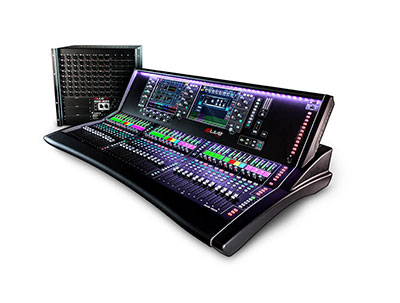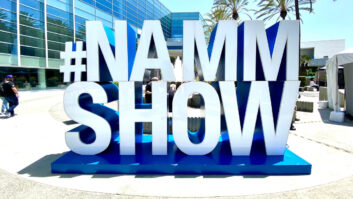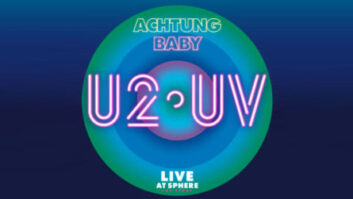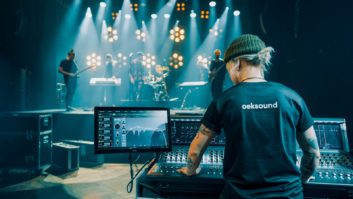
This baker’s dozen represents the most interesting and promising new live mixing products in 2015, whether big, small or somewhere in between. While widely varied, the following mixers are at least relatable to one another in a few key areas: They are digital, with at least one incorporated touchscreen, third-party touchscreen/tablet control functionality, or both; offer comprehensive or expanded processing and recording features built-in; and are largely future-proofed for networkability via Dante and/or other Ethernet-based protocols.
Allen & Heath dLive
Built for live touring and world-class installation applications, the dLive Series offers a worksurface with “daylight” viewable color touchscreen and multi-gesture control for drag, drop, pinch and zoom manipulation; a customized, proprietary GUI widget section; color-based LED cascade view; and more. Bolstering this user-friendly feature set is a number of pro-grade tech specs: 24-bit, 96 kHz operation; expandability to 828 inputs, 848 outputs; and 2x 128-channel 24-bit/96 kHz option slots, all available in three surface sizes ranging from a single 12-inch color screen (S3000) to the 36-fader dual 12-inch color screen (S7000). A&H’s MR Series Digital Mix Racks comprise the “brains” of the dLive, with dual-redundant Gigabit links to its surface-mount, hot-swappable onboard power supply, 128×64 mix cores, reversible rack installation rails, the Me-1 Personal Monitor port, dual redundant DX ports for future expansions, and 3x 128-channel 24-bit/96 kHz option ports for connection to third-party networks.

Avid VENUE | S6L
Avid’s VENUE | S6L is a touch-based live sound mixing interface with tight integration with Pro Tools, touted as an ideal front-end to the Avid MediaCentral Platform, an end-to-end media management and distribution platform. Fully modular and scalable, it is “touch-based” via touchscreen workflows, unique ergonomics, and proprietary visual feedback. A strong point of the S6L is its plentiful onboard plug-ins and power to handle “huge channel and plug-in counts at the lowest possible latency.” All processing is at 96 kHz, and support for higher sample rates is possible. It can be scaled via I/O, the VENUE | Stage 64 rack; each Stage 64 can be stocked with up to 64 inputs and 32 outputs, selected from a variety of analog and digital option cards. Notably, VENUE | S6L uses “open” Ethernet AVB across all of its components, requiring either lightweight, inexpensive Cat-5e cables for runs up to 100 meters, or fiber-optic cables for longer runs up to 500 meters.

Behringer X18 X Air
Packing numerous features within a $699 street 18-channel, 12-bus mixer centered on an iPad or Android tablet, Behringer’s aspiring X18 X Air digital mixer promises a bevy of appealing capabilities. Those include 16 programmable Midas preamplifiers; built-in WiFi router for direct operation; 18×18 USB interface, designed for iOS tablet or PC recording; auto-mixing features, perfect for corporate/institutional applications; four stereo effects slots featuring parameters from the popular X32 digital mixer; UltraNet connectivity for P16-M Personal Monitor Mixers, etc.; and much more. The X18 X Air is yet to ship, but if its feature set is illustrative of its capabilities, it could ideal for multi-user, digital mixing settings (e.g., houses-of-worship market, schools, etc.); after all, it promises compatibility with platforms ranging from Android to iOS, and Linux to Mac. Stay tuned.

DiGiCo S21
The S21 is DiGiCo’s most affordable live mixer, bringing the high performance standards of its world-class SD7 to a head-turning price point of $6,995 (S21 surface). The core of the S21 is the company’s Stealth Digital Processing, with many of DiGiCo’s flagship features included as standard—such as the SD7’s FPGA algorithms and mic preamps from the 192kHz SD-Rack. Key features of the 96kHz S21 include 24 mic/line inputs, 12 analog outputs, 46 buses, dual multi-touch screens, 21 touch-sensitive moving faders, four layers of 10-fader banks with customizable layout, an integrated USB2 Audio I/O interface for recording and playback of up to 48 channels, eight effects engines, and much more.
While most of the mixers listed in this feature now include touch screens, DiGiCo notes that the company has been incorporating them in products as far back as 1997. No doubt, DiGiCo is continuing to innovate at the top level of live mixing technology and the buzz surrounding the S21 at InfoComm 2015, the mixer’s U.S. unveiling, echoes that sentiment.

Fairlight EVO.Live
Fairlight’s flagship digital mixer has recently received a significant update via Version 5.1 software; the EVO.Live now provides up to 200 channels, offering newly enhanced signal routing with up to 16 mix-minus, 24 sub and eight main buses. Further, options such as fly-in cart FX, off-line preparation via laptop and extended customization tools like optional lighting integration promise even more comprehensive control over complex live productions. Three EVO.Live models are available, any of which can be used together for a maximum of 60 faders: the standalone EVO.Live chassis measuring up to 104 inches, a small-format tabletop (TT) chassis at 28 inches wide for 12 faders and full center section and custom furniture mounted versions, per special order. Also playback and recording-ready, EVO.Live can be specified to record up to 128 audio signals with one track of full HD video while simultaneously mixing.

Mackie Designs DL32R With Dante
Mackie’s DL32R is a 32-channel digital live mixer controlled wirelessly from an iPad featuring 32×32 direct-to-drive multi-track recording/playback within a 3U rackmount chassis. Key features include 32 Onyx+ mic pres and 28 buses, Mackie’s Master Fader control app, and, most recently, the optional DL Dante Expansion Card for DL32R providing 32×32 channels of network audio I/O, allowing the mixer to be connected to any Dante-powered A/V network. Essentially, it’s a provided 32×14 digital snake, with tons of I/O plus all the benefits of a full-featured digital mixer.
I reviewed the buzzed-about DL32R earlier this year for Mix sister publication Pro Sound News. The gist was that it “covers the broadest range of audio tasks in the simplest way of any single product I’ve reviewed,” as I wrote at the time. “Considering its feature set and Mackie’s presence and power in the industry, the DL32R is poised to be the next big thing in all-inclusive audio capture, control, mixing and live recording production at $1,999 street. Add iPad, mics, cables and powered loudspeakers plus a CPU-based DAW or remote USB drive; that’s all for a complete and super-capable live sound reinforcement + multichannel recording system.”

PreSonus StudioLive CS18AI
With PreSonus’ new mixing surface for its innovative StudioLive RM Series rackmount digital mixers and the Studio One DAW, tactile surface fans now have a controller option besides touchscreens, PCs and a mouse. The CS18AI offers 18 100mm touch-sensitive motorized faders, control of up to 64 channels, traditional layer navigation, a built-in AVB Ethernet audio interface with dual XMAX preamplifiers, balanced TRS line inputs, and 2 XLR and stereo headphone outputs. The CS18AI is networked via AVB Ethernet and PreSonus’s own UCNET technology.

QSC TouchMix Series
QSC’s buzzed-about TouchMix Series of compact digital live mixers, the TouchMix-8 and TouchMix-16, feature built-in touchscreens with proprietary software and have thus far proven to be easy-to-use and quite a value. Simple Mode is akin to the “auto function on a DSLR camera,” explains QSC, while Advanced Mode allows experienced users to dig deep into a wealth of parameters: a four-band fully parametric EQ with HPF, gate, and compressor per input channel, four stereo processors with a full range of effects, 1/3-octave graphic EQ, multiple monitor mixes, and direct-to-USB multitrack capabilities. All this is packed into the size and weight of a laptop.

Solid State Logic Live
Incorporating more than 40 new software and hardware-based features, SSL’s Live Series L500 console becomes the L500 Plus, gaining what the company calls a “significant power increase” and improved functionality. The L500 Plus marks an increase from 192 to 256 mix paths, a doubling of effects processing power; meanwhile, the L300 also gains mix paths—from 128 to 192. Software-based refinements include the new Super-Q single-button-activated Query function; optional Dante interface card for up to 32 x 32 channels of redundant I/O at 96 kHz; SOLSA (SSL Offline Setup Application) remote control software, allowing creation and editing of Live console Showfiles on a laptop, desktop or tablet PC; new broadcast-friendly features; a two-operator console expander mode; and more.

Soundcraft Si Impact
Designed to offer the ergonomics of a compact analog console, the 40-input Soundcraft Si Impact featuring 32 mic/line inputs balances classic functionality with modern conveniences, such as ViSi iPad digital mixing control, built-in Stagebox connectivity for I/O expansion, and recording and playback via 32 x 32 USB I/O. Other features include Soundcraft’s own FaderGlow illumination technology, 40 DSP input channels, 31 output busses, 26 motorized faders, and a five-inch color touchscreen display for access to show setup, patching, effects and security parameters. By the power of association through parent company Harman, the Si Impact also offers recognizable effects and dynamics from BSS, Lexicon and dbx.

Soundcraft Ui Series Remote-Controlled Mixers
The new Ui12 and Ui16 Ui Series digital mixers each feature an integrated, onboard Wi-Fi router and can be controlled via a tablet, PC or smartphone with cross-platform compatibility via iOS, Android, Windows, Mac OS, and Linux devices—up to 10 control devices simultaneously. The 12-channel Ui12 offers four XLR combo mic/line inputs and four XLR mic inputs; the 16-channel Ui16 offers eight XLR combo mic/line and four XLR mic inputs. Features include built-in signal processing from dbx, DigiTech and Lexicon, including dbx AFS2, DigiTech Amp Modeling; fully recallable, remote-controlled mic gain and phantom power; 4-band parametric EQ; HPF, compressor, de-esser and noise gate on input channels; 31-band graphic EQ; noise gate and compressor on all outputs, plus real-time frequency analyzer (RTA) on inputs and outputs; comprehensive I/O and more.

Yamaha RIVAGE PM10
The latest PM Series mixer, Yamaha’s new flagship RIVAGE PM10, comprises the CS-R10 control surface, DSP-R10 DSP engine, RPio622 I/O rack, three RY cards and two HY cards. What does all this mean? Interesting, intriguing technologies abound in the RIVAGE PM10. It boasts a ground-up redesign of its analog circuitry and much more, including key features such as Yamaha’s new Hybrid Microphone Preamplifiers with modeled Rupert Neve Designs transformer circuitry and SILK processing; Rupert Neve Designs/Yamaha co-developed VCM models of Neve-designed outboard devices form the ’70s and ’80s; upgraded channel EQ and dynamics; 45 plug-ins for creative channel processing; a reproduced Eventide H3000 for live applications; and the TWINLANe ring network using multi-model optical fiber. TWINLANe is an original Yamaha protocol “that can handle up to 400 96kHz audio channels over distances of up to 300 meters with low latency and redundancy,” notes the company.

Yamaha TF Series
Centered on a touchscreen, the TF Series is nearly the best balance of traditional audio workflow and pervasive modern convenience available in mid-level, pro-capable digital mixing. I’m currently reviewing a TF Series console, the mid-sized TF3 with 24 inputs. Thus far I’ve appreciated Yamaha’s obvious commitment to developing mixing tools that are conducive with the flow and intuitiveness of modern consumer tech—touch-based GUIs, specifically, in Yamaha’s own TouchFlow Operation—as well as proactive collaboration across corporate boundaries—e.g., Shure’s creation of preset parameters for the TF Series encompassing equalization, dynamics, head amp gain, limiting and gating, all adjustable “in intensity with a single knob control,” best explained by Yamaha promotional literature. Then there’s further development of Yamaha’s “one-knob” effects—one-knob compressors and EQs with signal specific modes; as Yamaha promotional material summarizes, to “achieve outstanding results with minimum effort in the shortest possible time.” Any user, from novice church mixers to professionals, can appreciate these thoughtful TF Series features.
Strother Bullins is the Reviews Editor for NewBay Media’s AV/Pro Audio Group. Contact him at [email protected].







